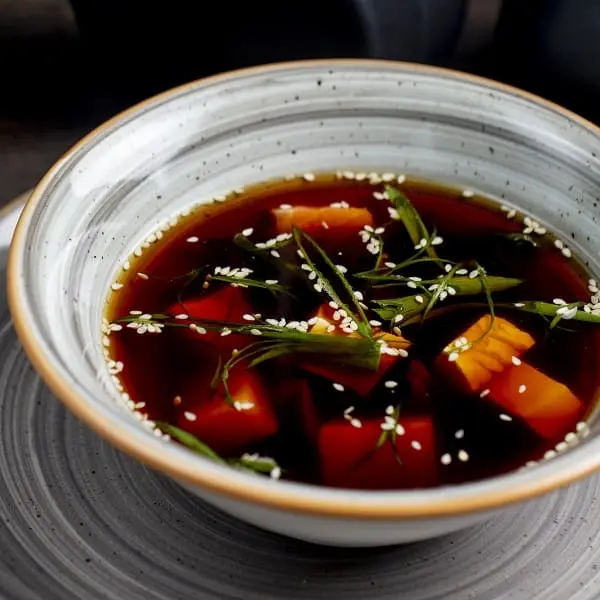Content
Soy sauce, a mainstay of Asian gastronomy, is an essential condiment, capable of transforming and enriching the taste profile of many preparations. However, in the event of shortages, allergies, gluten-free diets or a desire to reduce sodium consumption, what options are available to us?
How can we replace soy sauce without compromising taste and quality?
In this article, we explore 5 interesting alternatives to soy sauce, from natural choices to practical solutions, without sacrificing flavor. You’ll discover substitutes such as tamari, Worcestershire sauce, liquid amino acids, fish sauce and Kelpamare. We’ll show you why to opt for these alternatives, how to select them and incorporate them effectively into your recipes.
You’ll be able to diversify your dishes while discovering the benefits of these soy sauce substitutes.

Why look for alternatives to soy sauce?
Soy sauce, famous for its exquisite umami taste, may sometimes require substitutes due to dietary constraints or personal preferences. Let’s take a look at the main reasons why you might be looking for an alternative:
Soy allergy
Soy is one of the main allergens and can cause severe reactions. For those allergic to it, we recommend exploring options such as liquid coconut amino acids or Worcestershire sauce, which do not contain soy.
Gluten-free diet
The traditional composition of soy sauce includes wheat, making it incompatible with a gluten-free diet. Tamari, a gluten-free alternative made from fermented soybeans, or other gluten-free options such as fish sauce or balsamic vinegar, may be wise choices.
Salt consumption
Due to its high salt content, soy sauce may not be recommended for people who watch their sodium intake or suffer from high blood pressure. To reduce this intake, consider diluting soy sauce in water or vegetable broth, or opt for less salty alternatives such as tamari or teriyaki sauce.
Varying flavours
To avoid monotony of taste or to avoid overshadowing the other flavors in a dish, consider diversifying with substitutes such as curry, Kelpamare or oyster sauce. Preparing homemade soy sauce also lets you customize flavors to suit your own preferences.
5 natural, tasty alternatives to soy sauce
Looking for natural, tasty alternatives to soy sauce? Discover 5 easy-to-find or make-your-own alternatives to enrich your dishes with new flavors.
1. Tamari sauce: the gluten-free alternative
Made from the fermentation of wheat-free soybeans, Tamari sauce is ideal for people on a gluten-free diet. It has a richer, less salty taste than traditional soy sauce, but a slightly thicker texture. Perfect for stir-fries, marinades, sauces and dips, it lends itself to a wide range of culinary uses.
2. Coconut aminos: a mild, less salty alternative
Made by fermenting coconut sap with sea salt and spices, coconut aminos are soy- and gluten-free. Softer and less salty, it adds a sweet, tropical dimension while retaining its umami essence. Incorporate it into your preparations, whether Asian or Western.
3. Worcestershire sauce: a bold option with complex nuances
Made from vinegar, molasses, sugar, water, chili pepper, soy sauce, onions, garlic, lemon juice, anchovies and spices, Worcestershire sauce is distinguished by its sweet-tart flavor and acidity. Although it can replace soy sauce, it should be used sparingly so as not to overshadow the other flavors of the dish. It goes well with meats, vegetables, soups and stews.
4. Diluted miso: a versatile umami touch
Miso, a fermented paste made from soy, rice or barley, is a condiment of choice in Japanese cuisine, rich in umami flavor. To use it as a substitute for soy sauce, dilute a tablespoon of miso in a quarter cup of hot water, adjusting the salt to taste. This mixture makes an excellent substitute for stir-fries, marinades, vinaigrettes or soups.
5. Concentrated vegetable broth: when simplicity rhymes with taste
Concentrated vegetable broth offers a simple, effective alternative to soy sauce, providing a comparable richness of flavor while being less salty and more natural. Available in cube, powder or liquid form, it is easily diluted in hot water.
This broth can then be used in the same way as soy sauce in your culinary preparations. For an extra touch of acidity, don’t hesitate to add a little balsamic vinegar.

How to choose and use these alternatives?
To help you choose and use these 5 alternatives to soy sauce in your culinary preparations, here are a few recommendations:
Consider your dietary requirements and taste preferences. If you can’t tolerate soy or gluten, opt for options without these components, such as gluten-free tamari, coconut aminos or Worcestershire sauce.
To reduce salt intake, opt for less salty alternatives such as coconut aminos, diluted miso or vegetable stock concentrate.
If you like complex, spicy flavors, Worcestershire sauce, diluted miso or Kelpamare may be right for you.
Adjust the dosage according to the chosen alternative. Soy sauce alternatives vary in flavor intensity. It is therefore essential to modulate the quantities used. Worcestershire sauce and diluted miso, which are more full-bodied than traditional soy sauce, require more moderate use. Conversely, coconut aminos and concentrated vegetable broth, which are milder, can be used more generously.
Feel free to experiment. The various alternatives to soy sauce can enrich your recipes with unique flavors, especially if you combine them with each other or with other ingredients. For example, a blend of tamari, rice vinegar and sugar creates an exquisite sweet and sour sauce.
Coconut aminos, combined with lime juice and coriander, create a zesty, refreshing sauce. For an original touch, try combining Worcestershire sauce with ketchup and mustard to concoct a homemade barbecue sauce.
By the end of this article, you’ll know that there are a whole range of alternatives to soy sauce, ideal for those who lack this condiment, suffer from allergies, follow a gluten-free diet or are looking to reduce their salt intake.
We introduced you to five natural and tasty substitutes: tamari, coconut aminos, Worcestershire sauce, diluted miso and concentrated vegetable broth.
We also discussed how to select and incorporate them into your culinary preparations, assessing their specific flavours and characteristics.
Don’t wait any longer to experiment with these alternatives in your recipes. You’ll discover new ways to enhance your dishes while enjoying the benefits of these products.
- Soy Sauces – Kikkoman Home Cooks – kikkomanusa.com
- Discover also
- What are the benefits of black tea?
